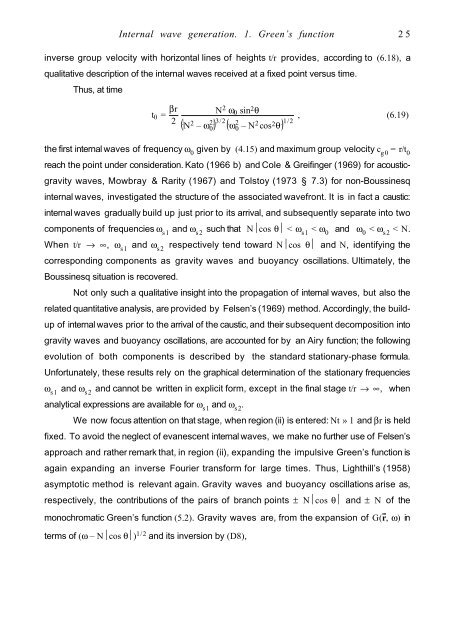Internal Wave Generation in Uniformly Stratified Fluids. 1 ... - LEGI
Internal Wave Generation in Uniformly Stratified Fluids. 1 ... - LEGI
Internal Wave Generation in Uniformly Stratified Fluids. 1 ... - LEGI
Create successful ePaper yourself
Turn your PDF publications into a flip-book with our unique Google optimized e-Paper software.
<strong>in</strong>verse group velocity with horizontal l<strong>in</strong>es of heights t/r provides, accord<strong>in</strong>g to (6.18), a<br />
qualitative description of the <strong>in</strong>ternal waves received at a fixed po<strong>in</strong>t versus time.<br />
Thus, at time<br />
t0 = βr<br />
2<br />
N 2 ω0 s<strong>in</strong> 2 θ<br />
N 2 – ω 0 2 3/2 ω0 2 – N 2 cos 2 θ 1/2<br />
, (6.19)<br />
the first <strong>in</strong>ternal waves of frequency ω 0 given by (4.15) and maximum group velocity c g0 = r/t 0<br />
reach the po<strong>in</strong>t under consideration. Kato (1966 b) and Cole & Greif<strong>in</strong>ger (1969) for acoustic-<br />
gravity waves, Mowbray & Rarity (1967) and Tolstoy (1973 § 7.3) for non-Bouss<strong>in</strong>esq<br />
<strong>in</strong>ternal waves, <strong>in</strong>vestigated the structure of the associated wavefront. It is <strong>in</strong> fact a caustic:<br />
<strong>in</strong>ternal waves gradually build up just prior to its arrival, and subsequently separate <strong>in</strong>to two<br />
components of frequencies ω s1 and ω s2 such that N⏐cos θ⏐ < ω s1 < ω 0 and ω 0 < ω s2 < N.<br />
When t/r → ∞, ω s1 and ω s2 respectively tend toward N⏐cos θ⏐ and N, identify<strong>in</strong>g the<br />
correspond<strong>in</strong>g components as gravity waves and buoyancy oscillations. Ultimately, the<br />
Bouss<strong>in</strong>esq situation is recovered.<br />
<strong>Internal</strong> wave generation. 1. Green’s function 25<br />
Not only such a qualitative <strong>in</strong>sight <strong>in</strong>to the propagation of <strong>in</strong>ternal waves, but also the<br />
related quantitative analysis, are provided by Felsen’s (1969) method. Accord<strong>in</strong>gly, the build-<br />
up of <strong>in</strong>ternal waves prior to the arrival of the caustic, and their subsequent decomposition <strong>in</strong>to<br />
gravity waves and buoyancy oscillations, are accounted for by an Airy function; the follow<strong>in</strong>g<br />
evolution of both components is described by the standard stationary-phase formula.<br />
Unfortunately, these results rely on the graphical determ<strong>in</strong>ation of the stationary frequencies<br />
ω s1 and ω s2 and cannot be written <strong>in</strong> explicit form, except <strong>in</strong> the f<strong>in</strong>al stage t/r → ∞, when<br />
analytical expressions are available for ω s1 and ω s2 .<br />
We now focus attention on that stage, when region (ii) is entered: Nt » 1 and βr is held<br />
fixed. To avoid the neglect of evanescent <strong>in</strong>ternal waves, we make no further use of Felsen’s<br />
approach and rather remark that, <strong>in</strong> region (ii), expand<strong>in</strong>g the impulsive Green’s function is<br />
aga<strong>in</strong> expand<strong>in</strong>g an <strong>in</strong>verse Fourier transform for large times. Thus, Lighthill’s (1958)<br />
asymptotic method is relevant aga<strong>in</strong>. Gravity waves and buoyancy oscillations arise as,<br />
respectively, the contributions of the pairs of branch po<strong>in</strong>ts ± N⏐cos θ⏐ and ± N of the<br />
monochromatic Green’s function (5.2). Gravity waves are, from the expansion of G(r, ω) <strong>in</strong><br />
terms of (ω – N⏐cos θ⏐) 1/2 and its <strong>in</strong>version by (D8),


